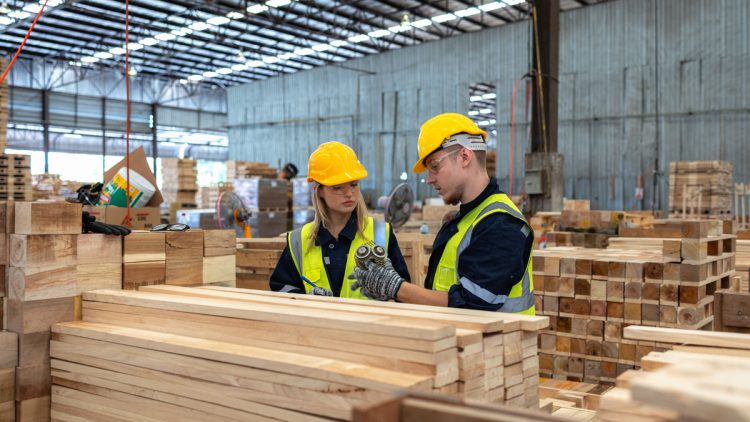Hardwood vs. Softwood
Different projects require different kinds of wood, and a lot of us are going to have come across the words ‘hardwood’ and ‘softwood’.
But what are the differences between these two kinds of wood? How can you differentiate them? What are the primary uses of each? Keep reading…
What Is the Difference Between Hardwoods And Softwoods?
Hardwoods and softwoods are defined by the trees they are harvested from. Hardwoods come from angiosperm species; mostly deciduous, they have broad leaves that fall every fall season. Softwood comes from gymnosperm trees, such as conifers. These have needles that stay evergreen all year long. Since hardwood trees grow slower than softwood trees, their wood is typically stronger and denser.
What Are Hardwoods?
Hardwoods are from trees classed as angiosperms that reproduce with a flowering plant, such as oak, maple and walnut. Located in tropical and temperate forests throughout the world, hardwood trees are mostly short lived, with wide leaves that switch color and fall down in the colder months. All these leaves have a system of fine veins.
The configuration of a hardwood is usually more complex than that of a softwood. Naturally, they grow slower than softwood trees — they can take up to one hundred and fifty years prior to being ready to harvest — which leads to the wood harvested from them being denser, heavy, and long lasting.
The term angiosperm transcribes as ‘enclosed seed’ — the tree’s seeds are encased in an ovule, like a nut or fruit. The seeds do not spread as easy, resulting in hardwood trees usually being more bunched together.
What Are Softwoods?
Softwood comes from gymnosperm trees, such as conifers (evergreen). These trees — such as spruces, pines, and cedars— have needle-like greenery that typically stays green all year, as opposed to broad leaves that fall in the autumn. Softwood trees grow quicker than hardwoods, typically taking around forty years prior to being ready to harvest. This quick-growing nature has an inclination of making them less dense than their equivalents.
The word gymnosperm transcribes from Greek basically to mean ‘revealed seed’; this is due to the seeds from these trees — like pinecones — are not encased in an ovule. They have no type of casing. Meaning they’re able to spread a lot more easily and quickly than hardwoods, oftentimes even because of wind.
Hardwood Vs. Softwood: Strength
As the name suggests, generally, hardwoods are stronger and more durable than softwoods. This is because of their slower growing time and more convoluted, compressed structure, resulting in greater density of the harvested wood. Generally, higher density comes to higher strength and toughness.
Hardwood Vs. Softwood: Durability
Due to their more complex, compressed structure, hardwoods typically perform better when exposed to the elements, in addition to having superior resistance to fire. Softwoods that are intended to stand up to the elements — like garden furniture — are typically treated, or ‘tanalised’, to enhance their exterior performance. Each of the hardwoods and softwoods are going to weather to a silverish-grey when left untreated.
Hardwood Vs. Softwood: Cost
Because they grow faster, easier to source and resulting in more abundant, softwoods are typically considerably less costly than hardwoods. Nevertheless, the price of any given hardwood or softwood is subject completely on the product and species selected, in addition to, of course, the amount required.
Some kinds of softwood are specifically favorable for certain applications resulting in their appearance and robustness — introducing Western Red Cedar. Therefore, these may go for a higher price than less-in-demand hardwood equivalents!
Hardwood Vs. Softwood: Workability
Generally, hardwoods are more complex and time consuming to work with and machine. They also typically don’t take paints, finishes, or other treatments as easy as softwoods. First-rate devices are needed to work with woods with a higher density.
Hardwood Vs. Softwood: Impact On the Environment & Sustainability
Both these types of wood remove carbon dioxide and are one-hundred percent sustainable, but softwood is typically more friendly to environmentally alternative. This is simply due to these trees growing faster than their hardwood equivalents, meaning they can be replenished quicker. Nevertheless, by sourcing wood from sustainably controlled forests, have no doubt that hardwoods can be very kind to our little planet, as well.
Woodworking Supplies Mesa by Timber Woodworking
Timber Woodworking offers hardwoods in Mesa, Arizona. We specialize in woodworking tools, equipment, and supplies for commercial woodworking cabinet shops or furniture manufacturers as well as the home shop hobbyist. Contact us today, or call if you should have any questions.

